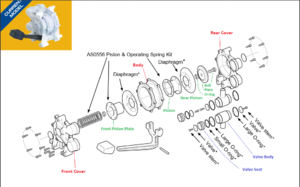Difference between revisions of "Whale Gusher Galley Mk3 Service Kit"
Dancrosswis (talk | contribs) |
Dancrosswis (talk | contribs) |
||
| Line 35: | Line 35: | ||
##Remove valve seat small O-ring and discard. | ##Remove valve seat small O-ring and discard. | ||
##Remove valve stems and valves and discard. The valve stems can be pulled out with pliers and pushed in from the outside of the outflow valve. | ##Remove valve stems and valves and discard. The valve stems can be pulled out with pliers and pushed in from the outside of the outflow valve. | ||
| + | #Reassemble rear diaphragm. Insert piston bolt through rear piston plate. Install piston O-ring on inner side of rear piston plate. Center rear diaphragm on the rear piston plate, with the concave surface of the diaphragm facing towards the rear cover. Screw the rear diaphragm assembly to the piston assembly with the piston bolt. See Figure 10. | ||
==Reassembly== | ==Reassembly== | ||
| Line 45: | Line 46: | ||
#'''Reassemble outflow valve.''' The outflow valve has valves and valve stems on the <u>inside</u> of the valve body. | #'''Reassemble outflow valve.''' The outflow valve has valves and valve stems on the <u>inside</u> of the valve body. | ||
##Install new valve and valve stem to inside of valve body. Valve’s concave side will face outward to meet the valve body. I propped the valve and valve stem on the intake valve body nipple, see Figure 8, to get the valve/stem assembly into valve body. Needle nose pliers may also work. | ##Install new valve and valve stem to inside of valve body. Valve’s concave side will face outward to meet the valve body. I propped the valve and valve stem on the intake valve body nipple, see Figure 8, to get the valve/stem assembly into valve body. Needle nose pliers may also work. | ||
| + | ##Install new valve and valve stem to remaining valve seat. Again, the valve’s concave surface faces the concave surface of valve seat. | ||
| + | ##Reseat valve seat. Place new small O-ring on valve seat. Apply dish soap to O-ring. Press seat into valve body with the valve on the inside of the valve body. See Figure 7 for assembled valve assemblies. | ||
| + | #'''Reassemble front diaphragm.''' First, a note on diaphragm orientation. The diaphragms are identical. Either can be used for the front or back. Each diaphragm is installed with its concave surface facing outward toward its cover. Just in case your diaphragm is inverted, the raised inner and out rims are on the <u>convex</u> side of the diaphragm. | ||
| + | ##Insert front piston plate into new front diaphragm. Concave side of the diaphragm will face towards the front cover. | ||
| + | ##Slide front piston plate into piston (which should be in the body). See Figure 9. | ||
|valign="top"|[[File:Pump_Exploded_View.png|thumb|left|Figure 1]] | |valign="top"|[[File:Pump_Exploded_View.png|thumb|left|Figure 1]] | ||
| Line 54: | Line 60: | ||
image:Tapping_Out_Valve_Seat.JPG|Figure 6 | image:Tapping_Out_Valve_Seat.JPG|Figure 6 | ||
image:Valve_Orientation.JPG|Figure 7 | image:Valve_Orientation.JPG|Figure 7 | ||
| + | image:Installling_valve.JPG|Figure 8 | ||
| + | image:Front_Reassembly.JPG|Figure 9 | ||
Revision as of 03:29, 12 October 2016
Intro
The following are the steps I developed when installing service kits for my two Whale Gusher Galley Mk 3 foot pumps. These pumps have been manufactured since 1984, so I suspect they will be found on most all of our boats. The service kit is part number AK0553. It is widely available. I bought my kits on eBay. They looked like old stock, but the parts were fine. I have serviced two pumps, so I have limited experience. The following procedures worked for me. But, they may not all be correct (please mention any needed corrections) and certainly are not the sole way to accomplish this task.
Naming Parts
|
I found a pump exploded view with names for most of the kit parts. I could not find a view which names each pump part. So, I made up some part names to help with my description. My inventions are listed below and shown in Figure 1:
Disassembly
ReassemblySee the Observations at end of this article to change pump from right to left hand or to change the valve intake position from bottom to top.
|
<gallery perrow=2 caption="Click on thumbnails to enlarge"> image:Remove_Lever_Screws.JPG|Figure 2 image:Remove_Rear_Cover.JPG|Figure 3 image:Pry_Off_Diaphragm.JPG|Figure 4 image:Front_Cover_Removed.JPG|Figure 5 image:Tapping_Out_Valve_Seat.JPG|Figure 6 image:Valve_Orientation.JPG|Figure 7 image:Installling_valve.JPG|Figure 8 image:Front_Reassembly.JPG|Figure 9 |
